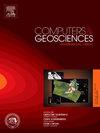A study on grille structure modeling algorithm for fault-controlled fractured-cavity reservoirs: A case study of the shunbei no. 5 fault zone
IF 4.4
2区 地球科学
Q1 COMPUTER SCIENCE, INTERDISCIPLINARY APPLICATIONS
引用次数: 0
Abstract
Establishing high-resolution 3D geological models of fault-controlled reservoirs is crucial for optimizing well placement and development plan. Carbonate fault-controlled fracture-cavity reservoirs in the Shunbei area of the Tarim Basin, Northwest China, exhibit complex heterogeneity. These reservoirs typically comprise fracture planes, caves and disordered bodies. Fracture planes are narrow and banded, with caves and disordered bodies distributed around them. Within fracture planes and caves, crush belts and bedrock belts alternate to form grille structures. These pose significant challenges for traditional modeling algorithms to characterize accurately. To address this, we proposed a hierarchical object-based modeling algorithm to reproduce fault-controlled fracture-cavity body's grille structural trends and shapes. Using seismic data from the Shunbei No.5 Fault Zone (with a resolution of 25∗25m) and well logging data (including drilling fluid loss data and resistivity logging data), conduct research on grille structure modeling algorithms. First, the fault-controlled fracture-cavity reservoirs are distinguished by fracture planes, caves, and disordered bodies, and contour models are established via seismic attributes threshold truncation. Second, statistics on the scale of development of crush belts and breccia belts under 100 m of fracture planes and caves in different stress sections by logging data. A regional growth tracking algorithm are applied to identify fracture planes trend lines, which can be classified into single, multi, convergent, and branching forms based on contour characteristics. Third, cumulative probability sampling is used to determine the number and scale of the crush and breccia belts. Grille structure models were constructed at three levels: bedrock, crush, and breccia belts. Results indicate successful identification of trend lines matching the structural contours, establishing accurate grille structure models by employing hierarchical simulation strategy under trend line constraints. The models established by traditional methods exhibit significant randomness, making it difficult to control both the variable developmental trajectories of individual belts and the relative positional relationships among multiple belts. Based on these geological facies models, corresponding physical property models were generated, achieving high accuracy in reserve calculations and numerical simulations with less than 10 % error, thus providing valuable guidance for oil and gas development. In the future, more compatible contour models can be established through methods like multi-attribute fusion and deep learning. By integrating production data, the developmental positions and connectivity of grille belts can be constrained.
断控缝洞型油藏格栅结构建模算法研究——以顺北油田为例。5断裂带
建立断控油藏的高分辨率三维地质模型对于优化井位和开发方案至关重要。塔里木盆地顺北地区碳酸盐岩断控缝洞型储层具有复杂的非均质性。这些储层通常由裂缝面、溶洞和无序体组成。断裂面狭窄,呈带状,周围分布有溶洞和无序体。在裂隙面和溶洞内,破碎带和基岩带交替形成格栅结构。这些对传统建模算法的准确表征提出了重大挑战。为了解决这一问题,我们提出了一种基于分层对象的建模算法来再现断层控制缝洞体的格栅结构趋势和形状。利用顺北五断裂带地震资料(分辨率为25 * 25m)和测井资料(包括钻井液漏失和电阻率测井资料),开展格栅结构建模算法研究。首先,通过裂缝面、洞室和无序体对断控缝洞型储层进行区分,并通过地震属性阈值截断建立等高线模型;其次,利用测井资料统计不同应力剖面100 m裂缝面和溶洞下破碎带和角砾岩带的发育规模。采用区域增长跟踪算法识别裂缝面趋势线,根据裂缝面趋势线的轮廓特征将裂缝面趋势线划分为单一、多、收敛和分支形式。第三,采用累积概率抽样法确定破碎带和角砾岩带的数量和规模。在基岩带、破碎带和角砾岩带三个层次建立了格栅结构模型。结果表明,在趋势线约束下,采用分层仿真策略,成功识别出与结构轮廓相匹配的趋势线,建立了精确的格栅结构模型。传统方法建立的模型具有显著的随机性,难以控制单个带的可变发展轨迹和多个带之间的相对位置关系。根据这些地质相模型建立相应的物性模型,实现了储量计算和数值模拟的高精度,误差小于10%,为油气开发提供了有价值的指导。未来,可以通过多属性融合和深度学习等方法建立更加兼容的轮廓模型。通过整合生产数据,可以约束格栅带的发展位置和连通性。
本文章由计算机程序翻译,如有差异,请以英文原文为准。
求助全文
约1分钟内获得全文
求助全文
来源期刊

Computers & Geosciences
地学-地球科学综合
CiteScore
9.30
自引率
6.80%
发文量
164
审稿时长
3.4 months
期刊介绍:
Computers & Geosciences publishes high impact, original research at the interface between Computer Sciences and Geosciences. Publications should apply modern computer science paradigms, whether computational or informatics-based, to address problems in the geosciences.
 求助内容:
求助内容: 应助结果提醒方式:
应助结果提醒方式:


